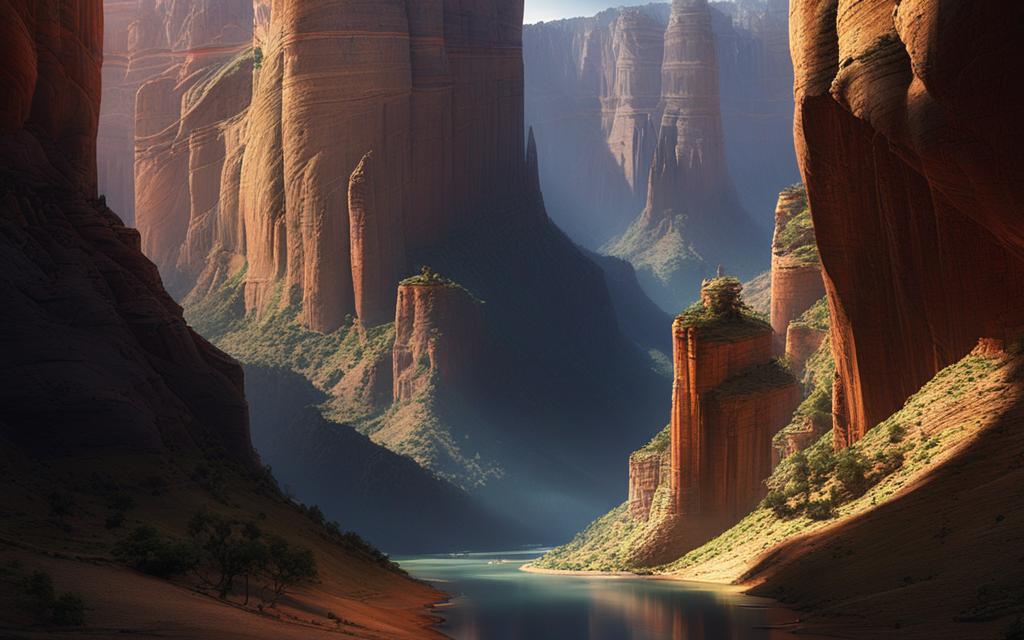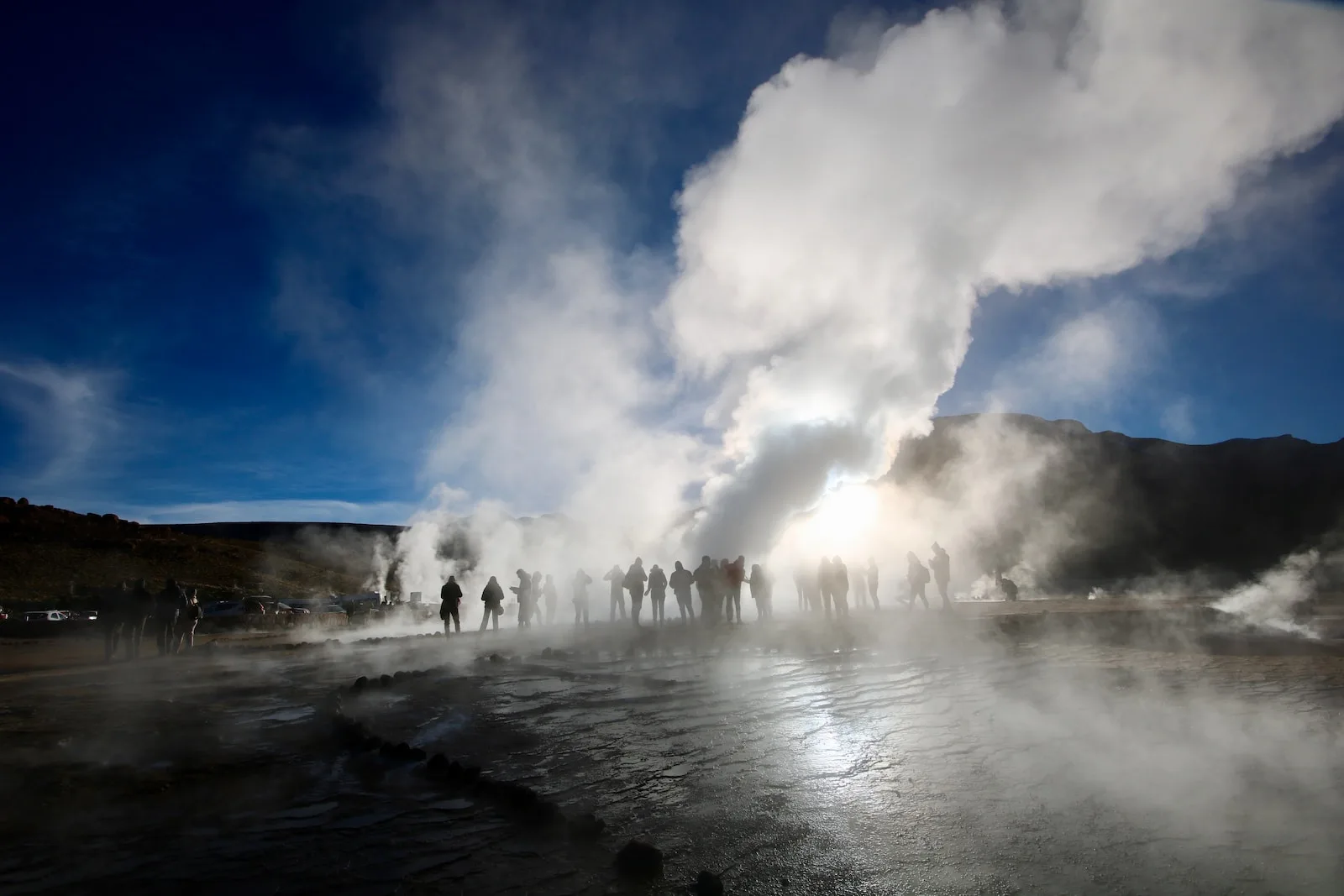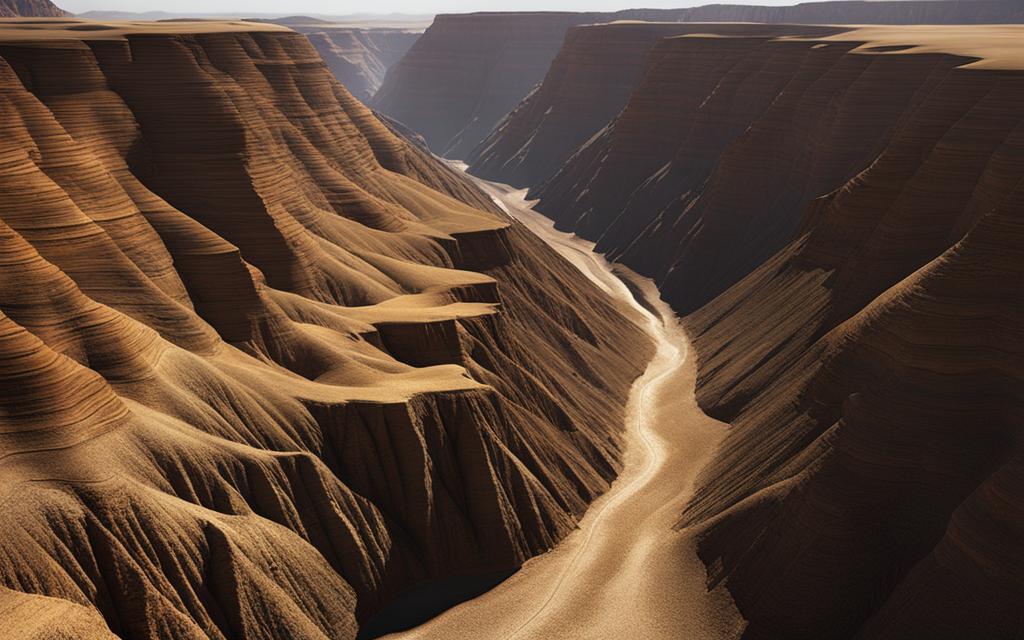Are you curious about the distinction between a canyon and a chasm? These natural wonders may seem similar at first glance, but they have unique characteristics and formation processes. Let’s delve into their definitions to gain a better understanding.
Key Takeaways:
- A canyon is a narrow chasm formed by river erosion over time, with steep cliff walls and often a flowing river.
- A chasm, on the other hand, is a deep fissure in the earth’s surface, created through various geological processes.
- Canyons and chasms share some similarities, such as deep openings and steep-sided walls.
- However, canyons are typically associated with flowing water, while chasms may lack water.
- Understanding the difference between canyons and chasms enhances our appreciation of their unique beauty and geological significance.
Canyon Characteristics
Canyons are geological formations characterized by their deep clefts, steep cliff walls, and the presence of flowing water, usually in the form of a river or stream. These natural wonders are typically formed over long periods of time through the erosive action of rivers, gradually carving away the underlying rock layers. Canyons can vary in width and length, but they are often narrow with lengths stretching for miles.
One distinct feature of canyons is their diverse wall structures. While some canyons have rugged and irregular walls, others feature smooth walls, especially in the case of slot canyons, which are very narrow canyons. The walls of a canyon can also reveal the various geological layers that have been exposed over time, showcasing a rich tapestry of rock formations.
In arid regions where canyons are commonly found, the physical weathering processes have a localized effect, causing the erosion and sculpting of the landscape. Canyons often form in areas where softer rock layers are intermingled with harder, more resistant layers. This differential erosion creates the dramatic cliff walls and intricate formations that are characteristic of canyons.
The Structure of Canyons
To better understand the characteristics of canyons, it is helpful to examine their structure. The following table illustrates the key features and attributes of canyons:
| Feature | Description |
|---|---|
| Deep Cleft | Canyons are characterized by their significant depth, often reaching hundreds or even thousands of feet. |
| Steep Cliff Walls | The walls of canyons are typically vertical or near-vertical, creating a striking visual impact. |
| Flowing Water | A defining characteristic of canyons is the presence of a river or stream, adding to their aesthetic appeal and ecological significance. |
| Narrow Width | Canyons can vary in width, but they are often relatively narrow, giving them a sense of grandeur and majesty. |
| Length | Unlike the width, canyons can stretch for miles, carving their way through vast landscapes and leaving a lasting impression. |
Visiting a canyon offers a unique opportunity to witness the power of geological processes and the stunning beauty they create. From the towering cliff walls to the mesmerizing waterways, canyons captivate the imagination and remind us of the dynamic forces that shape our planet.
Chasm Characteristics
A chasm is a geological feature characterized by its deep openings, steep-sided walls, and the absence of flowing water. Unlike canyons, which have rivers or streams running through them, chasms are defined by their sudden interruption of continuity. This unique attribute sets them apart from other landforms, making them intriguing and awe-inspiring natural wonders.
Chasms can vary in size, ranging from small fissures to large abysses or gorges. Their formation is not limited to a specific process but can occur through various geological activities. Tectonic activity, where the earth’s crust shifts and fractures, can create deep chasms in the landscape. Additionally, the collapse of cave systems or the creation of void spaces in the earth’s surface can also result in the formation of chasms.
Geographical areas with chasms are often associated with geological instability or disruption. These regions may experience frequent earthquakes, volcanic activity, or other geologically significant events. The presence of chasms highlights the dynamic nature of our planet and the powerful forces at work beneath the surface.
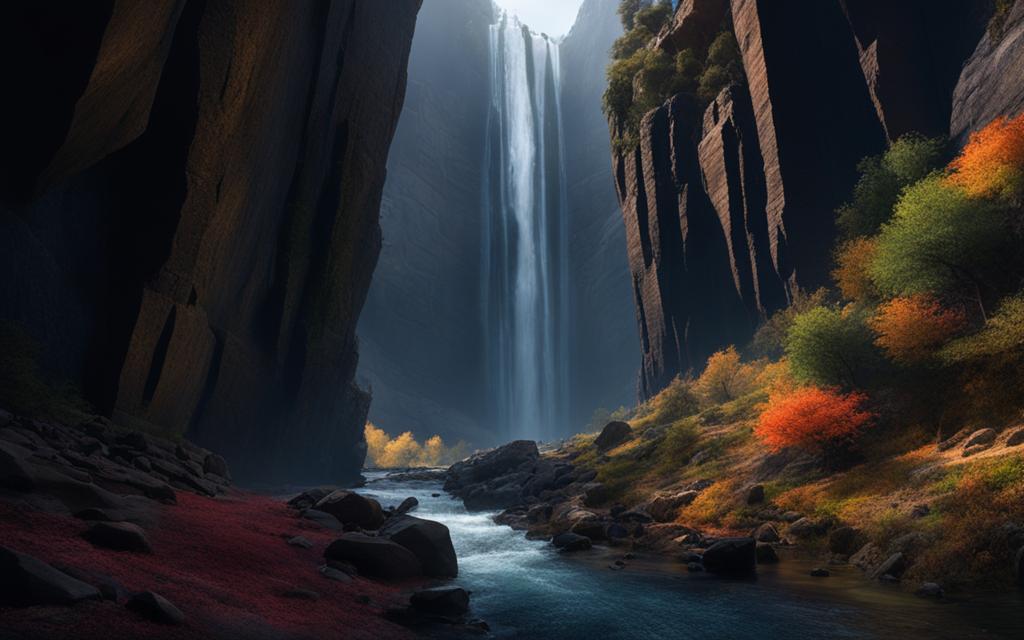
Notable Chasms Around the World
Chasms can be found in various parts of the world, captivating travelers and adventurers alike. Here are some notable chasms worth exploring:
- The Grand Canyon: One of the most famous chasms in the world, located in Arizona, United States.
- The Blyde River Canyon: A magnificent chasm in South Africa, known for its stunning panoramic views.
- The Verdon Gorge: Located in France, this chasm offers breathtaking views and opportunities for outdoor activities like hiking and rock climbing.
- The Simien Mountains: A UNESCO World Heritage site in Ethiopia, featuring dramatic chasms and breathtaking landscapes.
These are just a few examples of the diverse range of chasms that exist worldwide, each showcasing the beauty and power of nature in a unique way.
| Chasm Characteristics | Formation Processes | Geographical Locations |
|---|---|---|
| Deep openings | Tectonic activity | Grand Canyon, USA |
| Steep-sided walls | Collapse of cave systems | Blyde River Canyon, South Africa |
| Absence of flowing water | Creation of void spaces in the earth’s surface | Verdon Gorge, France |
| Geological instability or disruption | Simien Mountains, Ethiopia |
Similarities Between Canyon and Chasm
Despite their distinct characteristics, canyons and chasms share some similarities. Both geological features involve the creation of deep openings or clefts in the earth’s surface. They often exhibit steep-sided walls, adding to their dramatic appearance. Additionally, both canyons and chasms can be formed through natural processes, albeit different ones.
Canyons are primarily formed by the erosive action of rivers over geologic time scales. The gradual wearing away of rock layers, combined with the force of flowing water, carves out narrow chasms with steep cliff walls. Similarly, chasms can be created through various geological processes, such as tectonic activity or the collapse of cave systems. These processes result in deep openings in the earth’s surface, often described as abrupt interruptions of continuity.
While canyons are often associated with the presence of a river or stream flowing through them, chasms typically lack flowing water. However, both features can be found in diverse landscapes, ranging from arid regions to areas of geological instability. Despite their differences in formation, canyons and chasms are both natural wonders that showcase the immense power and beauty of the Earth’s geological processes.
“Canyons and chasms are remarkable geological formations that create awe-inspiring landscapes. Their similarities lie in the creation of deep openings and steep-sided walls, while their differences stem from variations in formation processes and the presence of flowing water. Exploring these geological wonders allows us to appreciate the incredible forces shaping our planet.”
Examining these similarities between canyons and chasms provides insight into the diverse nature of our planet’s geology. Both features exhibit unique characteristics that capture the imagination and draw visitors to witness their grandeur. From the stunning slot canyons carved by rivers to the impressive chasms formed through tectonic activity, these geological formations stand as testaments to the Earth’s fascinating history.
Now, let’s explore the differences between canyons and chasms to gain a deeper understanding of these geological wonders.
Differences Between Canyon and Chasm
When exploring the geological wonders of the world, it is essential to understand the differences between canyons and chasms. While both are deep openings in the earth’s surface, they have distinct characteristics and formation processes that set them apart.
A key difference between canyons and chasms lies in the presence of flowing water. Canyons are typically associated with rivers or streams that carve through the deep clefts, creating breathtaking landscapes. On the other hand, chasms lack this flowing water, emphasizing their abrupt interruption of continuity and often embodying a profound difference in opinion or interests.
Another notable distinction is the formation process. Canyons are primarily shaped through the erosive action of rivers over geologic time scales. The continuous flow of water gradually wears away the underlying rock layers, resulting in the narrow, steep-walled canyons we admire today. In contrast, chasms can be formed through various geological processes, such as tectonic activity or the collapse of cave systems. These processes can create deep fissures in the earth’s surface, giving rise to the impressive chasms we encounter.
It is important to note that canyons are sometimes used interchangeably with the term gorge. While similar, there are subtle differences between the two. Canyons tend to be narrower and longer, stretching for miles, while gorges can have a wider expanse. These distinctions further highlight the unique characteristics of canyons and the diverse landscapes they create.
| Canyon | Chasm | |
|---|---|---|
| Presence of flowing water | Yes | No |
| Formation process | Primarily erosive action of rivers | Tectonic activity, collapse of cave systems, or void spaces |
| Width | Narrow | Varies |
| Length | Can stretch for miles | Varies |
| Associated term | Gorge | N/A |
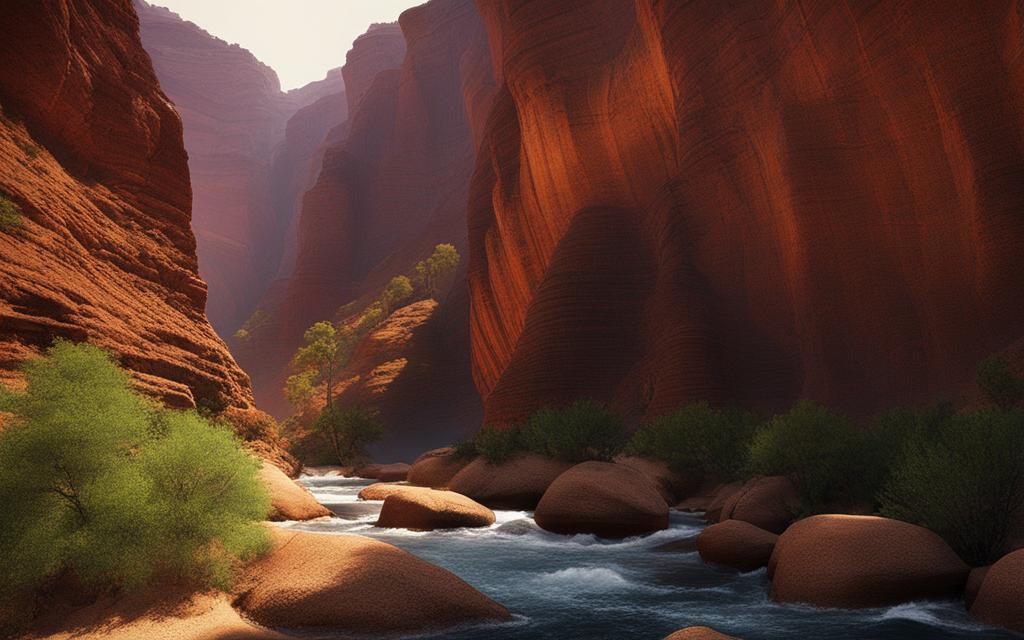 Understanding the differences between canyons and chasms allows us to appreciate the unique beauty and geology of these natural wonders. Whether it’s the awe-inspiring presence of flowing water in canyons or the enigmatic nature of chasms, each formation tells a captivating story of the earth’s intricate processes.
Understanding the differences between canyons and chasms allows us to appreciate the unique beauty and geology of these natural wonders. Whether it’s the awe-inspiring presence of flowing water in canyons or the enigmatic nature of chasms, each formation tells a captivating story of the earth’s intricate processes.
Conclusion
In conclusion, canyons and chasms are both fascinating geological features, but they have distinct characteristics and formation processes. Canyons are narrow chasms with steep cliff walls, usually accompanied by a flowing river, created through the erosive activity of rivers over long periods of time. On the other hand, chasms are deep openings in the earth’s surface, often associated with disruption or discontinuity, and can be formed through various geological processes like tectonic activity or cave system collapses.
While canyons and chasms share similarities such as their deep openings and steep-sided walls, they differ in terms of the presence of flowing water and the specific processes that form them. Canyons are closely tied to rivers, while chasms can be found in various types of landscapes. Canyons are often long and stretch for miles, whereas chasms can vary in size from small fissures to massive abysses or gorges.
Understanding the difference between canyons and chasms enhances our appreciation for the unique beauty and geology of these natural wonders. Whether it’s the awe-inspiring grandeur of a canyon or the mysterious depths of a chasm, these geological formations continue to captivate and intrigue us, reminding us of the incredible power and forces at work in shaping our planet.
FAQ
What is a canyon?
A canyon is a deep cleft between escarpments or cliffs resulting from the erosive activity of a river over geologic time scales. It is a narrow chasm with steep cliff walls, typically with a river flowing through it.
What is a chasm?
A chasm is a deep fissure in the earth’s surface, often described as a sudden interruption of continuity. It can be formed through various geological processes, including tectonic activity and collapse of cave systems.
How are canyons and chasms formed?
Canyons are primarily formed through the erosive action of rivers over geologic time scales, while chasms can be created through various geological processes, such as tectonic activity, collapse of cave systems, or the creation of void spaces in the earth’s surface.
What are the characteristics of canyons?
Canyons are characterized by their deep clefts, steep cliff walls, and the presence of a river or stream flowing through them. They can have narrow widths, be quite long, and have smooth walls in the case of slot canyons.
What are the characteristics of chasms?
Chasms are characterized by their deep openings, steep-sided walls, and the absence of flowing water. They can vary in size, from small fissures to large abysses or gorges. Chasms are often associated with areas of geological instability or disruption.
What are the similarities between canyons and chasms?
Both canyons and chasms involve the creation of deep openings or clefts in the earth’s surface. They often exhibit steep-sided walls and can be associated with discontinuity or disruption. Additionally, both canyons and chasms can be formed through natural processes, such as erosion, tectonic activity, or the collapse of cave systems.
What are the differences between canyons and chasms?
Canyons are typically characterized by the presence of a river or stream flowing through them, while chasms often lack flowing water. Canyons are primarily formed through river erosion, while chasms can be created through various geological processes. Canyons are often associated with narrow widths and can stretch for miles, whereas chasms can vary in size. Canyons are sometimes used interchangeably with the term gorge, but there are subtle differences between the two.
 Skip to main content
Skip to main content